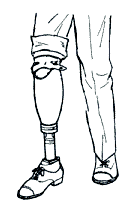 Fitting as soon after surgery as possible also helps to combat edema. A preparatory prosthesis is frequently used for several weeks or months until the stump has stabilized before the "permanent", or definitive, prosthesis is provided.
Fitting as soon after surgery as possible also helps to combat edema. A preparatory prosthesis is frequently used for several weeks or months until the stump has stabilized before the "permanent", or definitive, prosthesis is provided.
The socket of the preparatory prosthesis may be made of either plaster-of-Paris or a plastic material, and is usually attached to an artificial foot by an aluminum tube often called a "pylon". The aluminum pylons are usually designed so that the position, or alignment, of the foot with respect to the socket can be changed when necessary.
Although a variety of shoes may be worn with artificial limbs, the patient should consult with the prosthetist before selecting the shoes to be used because heel height is a major factor in alignment of the artificial leg.
A belt about the waist is usually used to help keep the prosthesis in its proper place on the stump. At least one prosthetic sock is worn between the socket and the body to provide for ventilation and to protect the skin from rubbing. Most prosthetic socks are woven of virgin wool, but socks of synthetic yarns are also used. Three thicknesses are available: 3 ply, 5 ply, and 6 ply. Additional socks can be used to compensate for stump shrinkage if the amount of shrinkage is not too great. The prosthetist and therapist can suggest the sock or socks to be used, but only the patient can determine the proper selection. (A chart to guide in selection of sock thickness is shown in Care of the Stump.)
Prosthetic socks must be changed daily to reduce the chance of irritation of the skin and dermatitis.
Prosthetic socks require special care in laundering. Instructions are provided by the manufacturers.
A specially woven nylon sock known as a prosthetic sheath is used by many amputees between the skin and the regular prosthetic sock to provide additional protection from abrasion. The sheath also allows perspiration to escape to the prosthetic sock and thus to the atmosphere.
The electronic version of this manual is presented by Dankmeyer, Inc., with the permission of the authors. This manual may not be redistributed in any form.